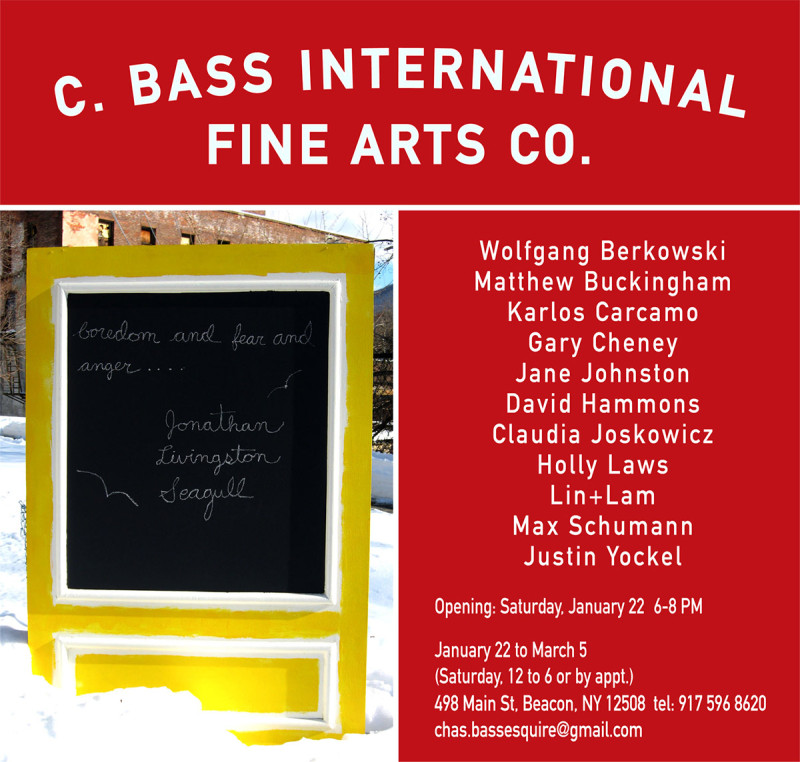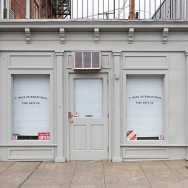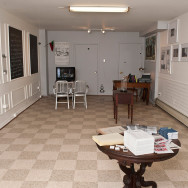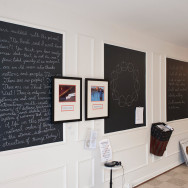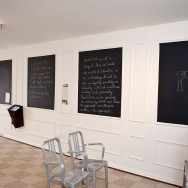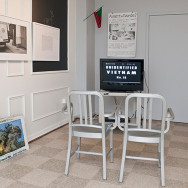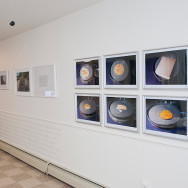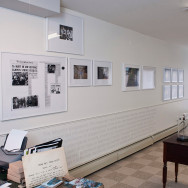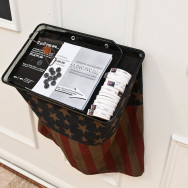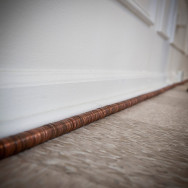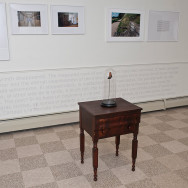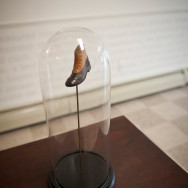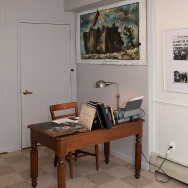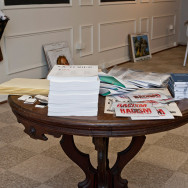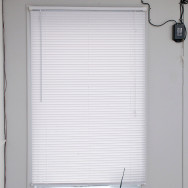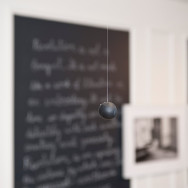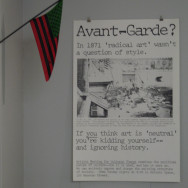C. Bass International Fine Arts Co. is an experimental commercial venture located in a small 1940’s storefront on Main Street in art world “outpost” Beacon, NY. Its projects encompass an interdisciplinary approach that references art history, cultural studies, material culture, and popular culture.
The second project entitled Chapter 2: boredom and fear and anger…..Jonathan Livingston Seagull draws on Jean-Luc Godard’s 1967 film La Chinoise in which radical students have re-purposed a bourgeois Parisian apartment for use as a place to meet and educate one another. The physical space of the exhibition uses decorative molding and visual motifs inspired by Godard to allow the viewer to enter a space similar to the film. The space then becomes not quite a gallery and not quite an apartment, but a hybrid space that is anything but neutral. Godard’s film hints at the notion that art, like politics, takes place in a rarefied world of intellectual and economic privilege. La Chinoise was made at a time of corresponding political turmoil in France and in America. But can art and culture really affect societal and political change if, as Jacques Rancière states, “the whole basis of politics is the struggle between the poor and the rich” or, more precisely, “the struggle between those who have no part in the management of the common and those who control it”…. Someone in America excluded from these rarified worlds might well ask of both art and politics what does any of this have to do with me? And there might be no good answer. Each of the artists in this exhibition addresses this
dilemma. Wolfgang Berkowski’s Hard Rain (2011) references Godard’s handmade props in La Chinoise, where tiny toy airplanes rain down bombs on one of the apartment’s inhabitants as well as Bob Dylan’s song A Hard Rain’s Gonna Fall, first recorded in 1963. Berkowski’s work implies that threat to a nation’s citizenry comes from within and without. Matthew Buckingham and David Hammons each take up the language of symbols as political language. In the first of Buckingham’s series exhibited here entitled Peace/Anarchy (2004), he pairs photographs he has taken of common symbols executed as graffiti that are universally and internationally potent, such as a swastika and a peace symbol with didactic historical texts that offer an often surprising, lesser
known history of each symbol. David Hammons takes on the American flag by recasting the colors as red, green and black, thereby claiming the flag in the name of the Black Power movement prominent in the 1960s and 1970s in America. In Jane Johnston’s two works Complaint (2004) and Newburgh Kitchen (2011), Johnston uses parody as a tool to critique national politics as well as local scandals in nearby Newburgh, NY, in her dual function as a citizen and as an artist. There is a parodic impulse in Justin Yockel’s installation as well, where 1 penny equals $100,000, but he is dead serious concerning the superfluity of large fortunes, urging the viewer to consider whether or not billionaires should exist. Karlos Carcamo’s language based work turns Conceptual art on its head by insisting both on the physicality of language and its visual power in producing social and political meaning at the local, national and global levels. Both Claudia Joskowicz and Holly Laws focus on the body as a political site. Claudia Joskowicz’s haunting video depicts Che Guevara’s dead body unceremoniously deposited on a cement slab; a revolutionary voice undimmed by death. Holly Laws’ metonymic work, where a tiny left boot stands in for the whole of the fascist Italian leader Mussolini’s body and soul, is like a miniature container for fascism itself. In Lin + Lam’s Unidentified Vietnam (2003-present), represented here through photographs and film, the artists
examine a collection in the Library of Congress in a consideration of U.S. military intervention in Vietnam, in their words, “offering a view of the present moment through the lens of past events.” In another evocation of history and protest, Matthew Buckingham’s series Will Someone Please Explain it to me, I’ve Just Become a Radical (2008) pans through now empty hallways at the University of Wisconsin which were once the site of a student demonstration against the Dow Chemical Company on October 18, 1967; in Buckingham’s words the moment “mark(ed) a turning point in
both the anti-war movement and in law enforcement’s response to that movement.” Finally, Max Schumann’s lush paintings on debased and discarded materials such as cardboard incorporate text ranging from political slogans to song lyrics and critique the art market on two levels. First, Schumann’s use of re-purposed cast-offs scoffs at the art market’s obsession with preservation and conservation, and, secondly, his pricing structure, ranging from $1.00 to thousands of dollars, turns the collector into a shameless consumer and interferes with the notion of value and pricing
so important in an art world ruled by commerce and auction houses.
Vietnam war veteran and anti-war activist Gary Cheney will host counter-recruiting seminars during the course of this exhibition (dates to be announced).
C. Bass International Fine Arts Co. 498 Main St, Beacon, NY 12508 tel: 917 596 8620
chas.bassesquire@gmail.com
- installation view
- installation view with Johnston and Yockel
- installation view
- installation view with Schumann, Lin+Lam and Hammons
- instllation view with Buckingham and Lin + Lam
- Karlos Carcamo
- Matthew Buckingham
- Justin Yockel
- Justin Yockel, detail
- installation view with Buckingham, Carcamo and Laws
- Holly Laws
- Max Schumann
- documents table
- Karlos Carcamo
- Wolfgang Berkowski
- David Hammons with poster by Art Workers Coalition

